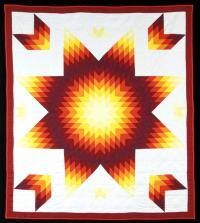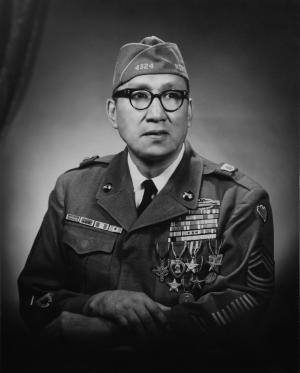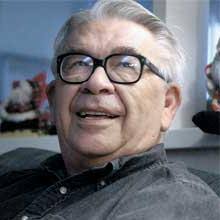Contributions
The Dakota have lived and traveled in what is now called the United States for thousands of years. Their values and many contributions have enabled life today. In areas ranging from science, food, medicine, art, and political organization, the Dakota created a model for sustainable life in the Upper Midwest.
Foods like the "Three Sisters"--corn, squash, and beans--were staples of Dakota diet before contact with Europeans. The buffalo's meat, hide, and bones were used for food, tools, and clothing. Maple trees provided natural sugar for cooking, and one of the earliest forms of candy. Sustainable ways of hunting and farming were valued and provided a model for responsible stewardship of the earth. 
The councils of the Oceti Ŝakowiŋ were a form of democracy, maintaining a tradition that was upheld by Indian nations for thousands of years. Militarily, Native Americans, including the Dakota, have defended the United States in the highest proportional numbers of any racial or ethnic group.
Dakota artwork such as quilting, beading, and painting still speak to us today.
Dakota stories and scientists still inform us about human creation, evolution, and natural processes on earth and in space.
Dakota language informs us about the first names of places we see everyday, reminding us that the land we live on has an immensely broad history. Its words also remind us of the customs, relationships, and spirituality within language and connect us in a meaningful way with each other.
Theme:
Life TodayPermissions beyond the scope of this license may be available at Copyright and Use Information.
Bibliography
Cash, Joseph H., and Herbert T. Hoover. To Be an Indian: An Oral History. New York: Holt, Rinehart, and Winston, 1971.
Resources for Further Research
Websites
Lakota and Dakota Sioux Fact Sheet
Primary
Cash, Joseph H., and Herbert T. Hoover. To Be an Indian: An Oral History. New York: Holt, Rinehart, and Winston, 1971
U.S.-Dakota War of 1862 Oral History Project. Minnesota Historical Society.
Key People

Woodrow Wilson Keeble
"Keeble was the embodiment of Wo´yuonihaŋ (honor)."
Russell Hawkins, Keeble's stepson, 2008.
Woodrow Wilson Keeble was born in 1917 in in Waubay, South Dakota. When young, he moved to Wahpeton, North Dakota, and became a member of the Sisseton Wahpeton Oyate. After his mother died, Keeble's father, who was too impoverished to feed his family, permanently enrolled Woodrow and his siblings in the Wahpeton Indian School.
Keeble excelled in sports, especially baseball, and pitched the Wahpeton amateur team to 10 straight victories. He was being recruited by the Chicago White Sox when his Army National Guard unit was called up to serve in World War II, becoming the North Dakota 164th Infantry Regiment. The 164th fought in several famous battles in the Pacific Theater of the war--Guadalcanal, Leyte, and Mindanao among them. During the Korean War, the 164th was again deployed, and Sgt. Wilson distinguished himself several times in combat. He returned to Wahpeton and died there in 1982.
Following a long campaign by his family and the congressional delegations of both North and South Dakota, Keeble was posthumously awarded the Medal of Honor on March 3, 2008 by President George W. Bush for his actions in the Korean War. Keeble had previously been awarded the Distinguished Service Cross, the Silver Star, the Bronze Star with V device for Valor, the Bronze Star for merit, and the Combat Infantryman Badge (first and second awards). Although he was wounded at least twice in World War II and three times in Korea, he received only two Purple Hearts. His Medal of Honor was the first ever awarded to a member of the Dakota nation.
American Indians in the Military
American Indians have served in all our nation's wars even though they were not granted legal citizenship until 1924. Twelve thousand Native Americans served in World War I, 44,000 (of a total population of 350,000 Native Americans at the time) served in World War II, and 42,000 (more than 90 percent of whom were volunteers) served in Vietnam. Native Americans still have the highest record of service per capita of all the ethnic groups in U.S. history.
In World War II, the United States used Navajo code talkers, as well as Lakota speakers, to transmit coded messages.

Zitkala-Ša
Zitkala-Ša (Red Bird) was born in 1876 on the Yankton Indian Reservation in South Dakota, the mixed-race daughter of a Dakota mother and a white father. Also known by ther missionary-given name, Gertrude Simmons Bonnin, Zitkala was a writer, editor, musician, teacher and political activist. She wrote several works chronicling her struggles in her youth as she was pulled back and forth between the influences of dominant American culture and her own Native American heritage, as well as books in English that brought traditional Native American stories to a widespread white readership. With William F. Hanson, Bonnin co-composed the first American Indian opera, The Sun Dance (composed in romantic style based on Ute and Sioux themes), which premiered in 1913. She founded the National Council of American Indians in 1926 to lobby for the rights of Native Americans to attain American citizenship, on which she served as president until her death in 1938.
View full article: Zitkala-Ša
John Trudell
"I'm just a human being trying to make it in a world that is very rapidly losing its understanding of being human."
John Trudell
John Trudell, born in 1946 in Omaha, Nebraska, is the son of a Santee Dakota father and a Mexican mother. He grew up near the Santee Reservation in northern Nebraska. He is an author, poet, actor, musician, and political activist. After serving in the Navy, he was the spokesperson for the United Indians of All Tribes' takeover of Alcatraz, which began in 1969, broadcasting as Radio Free Alcatraz. During most of the 1970s, he served as chairman of the American Indian Movement, based in Minneapolis. In 1979, a fire at a home on the Shoshone-Paiute Tribe's Duck Valley Indian Reservation in Nevada claimed the lives of Trudell's pregnant wife, three children and mother-in-law. Trudell, and others, believed that the fire was arson, and was an attempt to silence his family's activism. A Bureau of Indian Affairs police investigation claimed that it was accidental. After this tragedy, Trudell turned to writing, music, and film as a second career. He acted in three films in the 1990s. The documentary Trudell (2005) was made about him and his life as an activist and artist.
"When Columbus got off the boat, he asked us who we were. We said we’re the Human Beings, we’re the People.
Conceptually the Europeans didn’t understand that, it was beyond their conceptual reality. They didn’t see us. They couldn’t see who we were.
Historically speaking, we went from being Indians to pagans to savages to hostiles to militants to activists to Native Americans. It’s five hundred years later and they still can’t see us. We are still invisible.
They don’t see us as human beings, but we’ve been saying to them all along that’s what we are.
We are invisible to them because we are still the Human Beings, we’re still the People, but they will never call us that. They taught us to call ourselves Indians, now they’re teaching us to call ourselves Native Americans. It’s not who we are. We’re the People.
They can’t see us as human beings. But they can’t see themselves as human beings. The invisibility is at every level, it’s not just that we’re tucked away out of sight. We’re the evidence of the crime. They can’t deal with the reality of who we are because then they have to deal with the reality of what they have done. If they deal with the reality of who we are, they have to deal with the reality of who they aren’t.
So they have to fear us, not recognize us, not like us.
The very fact of calling us Indians creates a new identity for us, an identity that began with their arrival. Changing identity, creating a new perceptual reality, is another form of genocide. It’s like severing a spiritual umbilical cord that reaches into the ancestral past.
The history of the Indians begins with the arrival of the Europeans. The history of the People begins with the beginning of the history of the People.
The history of the People is one of cooperation, collectivity, and living in balance. The history of the Indians is one of being attacked and genocide, rather than a history of peace and balance. The history of the People under attack, the Indians, in an evolutionary context, is not very long, it’s only five hundred years.
The objective of civilizing us is to make Indian history become our permanent reality.
The neccessary objective of Native people is to outlast this attack, however long it takes, to keep our identity alive."
John Trudell
Happy Columbus Day Everybody.

Vine Deloria Jr.
"Before any final solution to American history can occur, a reconciliation must be effected between the spiritual owner of the land – American Indians – and the political owner of the land – American Whites. Guilt and accusations cannot continue to revolve in a vacuum without some effort at reaching a solution."
Vine Deloria Jr., from God Is Red: A Native View of Religion
Vine Victor Deloria, Jr. (1933-2005) was born in Martin, South Dakota. He was the grandson of Tipi Sapa (Black Lodge), also known as Rev. Philip Joseph Deloria, an Episcopal priest and a leader of the Yankton band of the Dakota Nation. Vine Deloria was an author, teacher, theologian, historian, and activist. His book Custer Died for Your Sins: An Indian Manifesto (1969) helped bring national attention to Native American issues. As professor of political science at the University of Arizona from 1978 to 1990, he established the country's first master's degree program in American Indian Studies.
